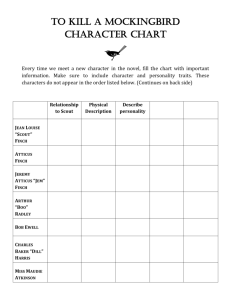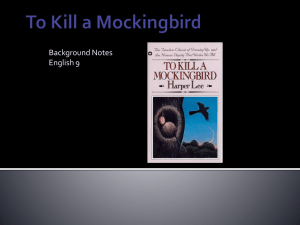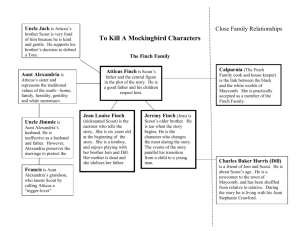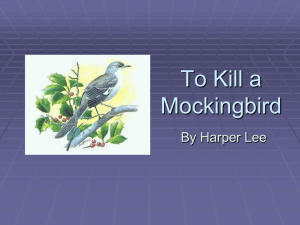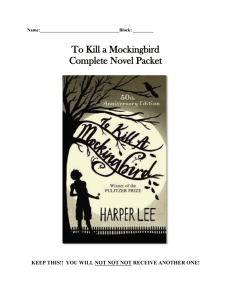to kill a mockingbird by harper lee
advertisement
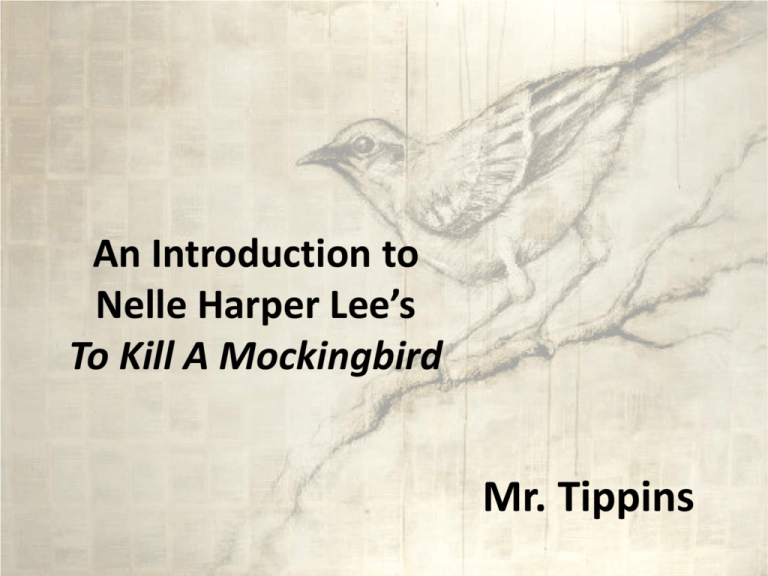
An Introduction to Nelle Harper Lee’s To Kill A Mockingbird Mr. Tippins Anticipation Guide 1. Even if people will be criticized for it, they should stand up for what they believe in. 2. Education can equalize people of different social and economic status. 3. Citizens should punish criminals if the law does not. Write agree or disagree, and write why. Nelle Harper Lee • Born April 28, 1926 in Monroeville, Alabama. • Her first and only novel To Kill a Mockingbird was published in 1960. • In 1960 she won the Pulitzer Prize for fiction. • Lee continued to receive awards after the book’s publication. • In November of 2007 she was awarded the Presidential Medal of Freedom (the nation’s highest civilian award) for her contribution to American literature. Semi-Autobiography Harper Lee versus Scout Finch - Born in Monroeville, Alabama - Born in Maycomb, Alabama - Grew up in 1930’s - Grew up in 1930’s - Father was a lawyer - Father (Atticus) is a lawyer - Mother’s maiden name was Finch - Last name = Finch There are two distinct plot forms in the novel. One could be described as a Bildungsroman, which means it is a story about growing up. The second is a recording of a particular period in American history. The Setting • The setting – Maycomb, Georgia – The novel is set in 19331935, which is during the Great Depression Time: 1930s, Great Depression era – People bought “on margin”, and an imbalance in supply and demand caused a major depression. Economic difficulties of this time caused problems for all classes of people. Many families do not even have money for basic needs such as food, clothing, and shelter. The per capita income for families in Alabama (and Oklahoma) was $125 - $250 a year. Many people travelled to find seasonal work but unemployment was at a peak. Many southern blacks picked cotton for a living. Race in Alabama • The agricultural economy was hit hard by the depression. Many white southerners had a romanticized idea of how life should be. They felt threatened by change and industrialization. Tensions between whites and blacks were still high. • Although slavery was abolished in the 1865, racism and discrimination were alive and well during the time of the novel. • However, in the South, there was still very little opportunity for African Americans to advance themselves. Nearly half did not receive an education past the 5th grade, and many picked cotton to survive throughout the Great Depression. Lynching also remained a common practice in Alabama and southern states. Segregation Race in Alabama, 1920-1940 No white female nurses in hospitals that treat black men Separate passenger cars for whites and blacks Separate waiting rooms for whites and blacks Separation of white and black convicts Separate schools No interracial marriages Segregated water fountains Segregated theatres Although free blacks in the north received the vote back in 1870, those in the southern states do not until 1964 with the introduction of the Civil Rights Act. Another Cultural Difference… • Gender Bias – Women were the weaker sex. – Education not important for women. – Women only received the right to vote in 1919. – Men were not expected to be nurturing. Keep the following in mind: Pay close attention to the language of the characters. For example, Atticus uses formal speech, the Ewells use curse words and obscenities, and the cook switches between “white” and “black” dialects depending on who she is talking to. Also, the book contains derogatory terms for African Americans, such as “nigger,” “darky,” “Negroes,” and “colored folk” – Lee uses such language to keep her novel naturally in sync with common language of the times. Characters Jean Louise Finch “Scout” The story’s narrator Although now an adult, Scout looks back at her childhood and tells of the momentous events and influential people of those years. Scout is six when the story begins. She is naturally curious about life. Characters Atticus Finch Father of Scout and Jem A widower An attorney by profession Highly respected Good citizen Instills good values and morals in his children. Characters Jem Finch Scout’s older brother Looks up to his father Atticus Usually looks out for Scout Typical older brother at times Smart Compassionate Matures as the story progresses Characters Calpurnia The Finch’s black housekeeper Has watched the children since their mother’s death Acts as a positive influence on the children. Characters Dill A close friend of Jem and Scout Usually lives in Maycomb only during the summer (stays with a relative) Tells “big stories” Has been deprived of love and affection Characters Tom Robinson A young, hardworking black male Has a crippled left hand Married with three children. Works on a farm belonging to Mr. Link Deas, a white man Characters Arthur “Boo” Radley An enigma An adult man, whose father has “sentenced” him to a lifetime confinement to their house because of some mischief he got into when he was a teenager. Has a reputation of being a lunatic The Task Introduction: In groups of two, you will complete a webquest research task on one topic related to the novel. Steps: 1.Choose one topic from the list on the handout. 2.Complete the handouts and begin your research. 3.Once you have gathered everything, your group will present your findings to the class (next week) in the form of a script, song, rap, speech, news article, lecture, video, or Power Point. Now lets look at our task handouts… Vocabulary for Chapter 1 and 2 Complete these in groups (define and share): • • • • • • • Assuaged Apothecary Strictures Dictum Chattel Vexations Taciturn - • • • • • • • Repertoire Vapid Malevolent Morbid Predilection Sojourn Domiciled -

